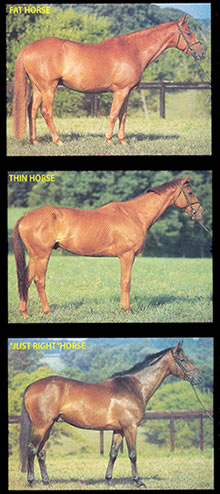Job 1: Provide Support
In founder, your horse’s coffin bone is trying to separate from the hoof wall and drop out through the bottom of his foot. You have to do something to physically push the coffin bone back up, allow him to rest his foot in whatever way reduces pressure and pain at the tip of the coffin bone, and transfer his weight onto the sole so the wall can ‘hang suspended’ and repair.

There are plenty of shoes, devices, and bandaging techniques intended to accomplish these three goals, but they typically require a professional to apply them-and have varying degrees of success. You can accomplish all three goals yourself with duct tape and pads made of 2-inch-thick blue builder’s styrofoam (two items I recommend for your home first aid kit).

Builder’s styrofoam is generally available, inexpensively, at lumberyards and building-supply stores. If you can’t find it, the less-dense 2-inch pink Styrofoam will do. Or, for $25, Hope for Soundness offers a “First Alert Kit” with four precut 2-inch pads, duct tape, and an instructional video including some tricks that make shaping and applying the Styrofoam smoother and easier.
When your horse puts weight on a foot supported with a Styrofoam pad, the foam will crush down the way he wants it to. You’ll then trim the pad so its area of support is entirely inside the white line-on the sole, not on the wall. If he isn’t more comfortable, you can modify the pad further. He’ll probably need a second pad added once he’s crushed the first one. He may want a new pad every time he stands up for a few days, until his laminae start to knit back together.

If his heels start to get mushy under the 24/7 duct tape, mix a little water-based Calendula gel ($5.29 for a 3.5-ounce “tub” at health-food stores) with a little Draw liquid poultice ($55.16 for 32 ounces online from Advanced Biological Concepts. Dampen (don’t soak) a bit of cotton in the mixture and lightly dab on the heels to dry them. (This preparation is also great for drying and drawing infection out of the coronary band.) Then replace the duct tape with Elasticon[R]. At $9 a roll from your vet or tack store, it’s fairly expensive but its advantage is that it “breathes.”

Help Him Get Horizontal
If you’re like most horse owners, you instinctively feel better when you see your sick horse standing up. But if you have a wound-a lacerated foot, say-you find a way to rest it, right? Founder is a big wound between your horse’s laminae. After supporting his foot with Styrofoam, the second best way to rest that wound is to encourage him to lie down in the early stages.
How? Make sure his bedding is very deep, comfy, cushy, and clean. Either shavings or sawdust is preferable to straw, which packs and gets very hard and urine-soaked overnight. Some veterinary hospitals find stalls bedded in sand very therapeutic-because sand conforms, which makes it comfortable to lie on, prevents bedsores, and (when the horse stands up) supports his foot and allows him to tip it however he wants. But setting up a sand stall is pretty expensive; if your ground is naturally sandy, a better idea is to put him outside-in an area no bigger than a good-sized stall so he won’t move around and tear those laminae further.
What if your vet suggests a nerve block to the foot? I say, “Don’t.” This may seem cruel, but you want your horse to hurt–at least enough that he wants to get off his feet; the longer he’s off them, the better. Even if he spends most of several days lying down, you can roll him over, clean around him, keep food and water within reach, and he can eat and drink in a prone position. Bedsores? Bedsores heal. They’re the least of his problems right now.
When he’s more comfortable, usually after a week or so, he’ll benefit from having room to move, fresh air, and company.
Excerpted from “Fight Founder Holistically,” which first appeared in the August 2002 issue of Practical Horseman. See the complete article for step-by-step instructions to making a supportive styrofoam pad, plus other holistic strategies for helping your horse heal.









